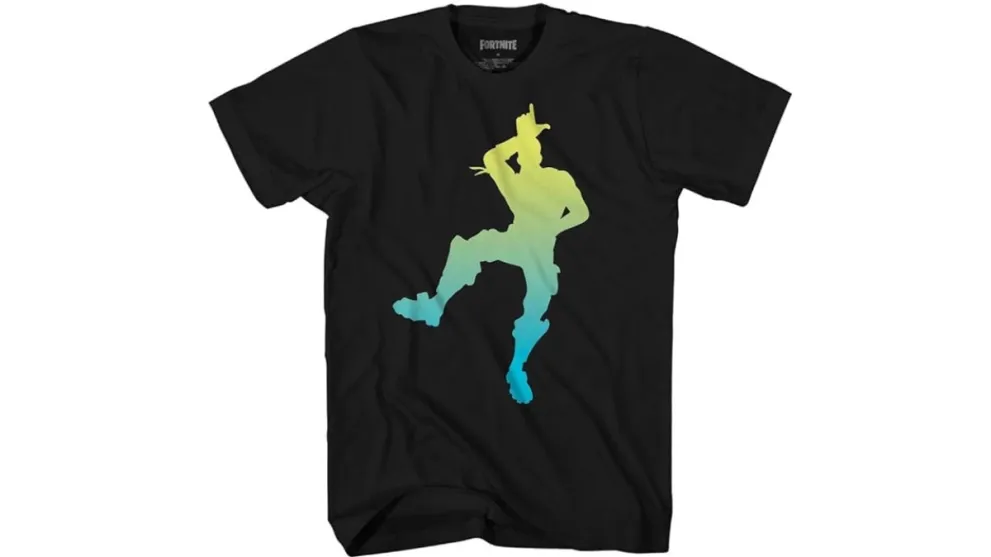You can’t jump into a Battle Royale without the right kit so we have a selection of the best shirts you can wear while playing Fortnite. From the cool to the absurd, these are the top 13 funniest Fortnite shirts to check out this year!
13. Gray Peely Shirt With Logo

A super a-PEEL-ing shirt featuring the iconic banana himself. This short-sleeved Peely t-shirt is 100% cotton and fully machine washable! It comes in a range of sizes suitable for any adult Fortnite fan from small to 5XL. The soft, comfortable shirt is styled in this smart light gray color with a large graphic print of the Fortnite logo with our little yellow guy sitting atop the F. Perfect for lounging around as you play or wearing to a family brunch.
12. Rippley Slurp Jar Tank Top

The perfect shirt for a hot summer’s day! Check out this lightweight tank top adorned with the friendly Slurp man, Rippley. When he’s not poured into a jar like this, Rippley is a muscle-bound guy made entirely from the healing Slurp Juice. How did he end up in a jar? It’s probably best not to ask. This poly-cotton blend tank top comes in three colors: black (shown above), navy blue, or dark gray, all of which really make the bright blue slurp pop! Grab one of these epic Fortnite shirts in whatever size you desire from small to XXL.
11. Take The L Emote Shirt

Are you dissatisfied with the lack of emote trolling IRL? Want to infuriate other Fortnite players while out in public? Then this Take The L emote shirt is perfect for you. This classic Fortnite emote is as obnoxious as it is funny. Although it is nowhere near as bad as the braying donkey of the Laugh It Up emote! This black t-shirt is 100% cotton and fully machine washable so you can feel safe knowing that it is fine to wash and wear repeatedly.
10. Peely Banana Anatomy T-Shirt

Peely is back and this time he is here to educate us on the anatomy of a sentient banana. The graphic print shows a waving Peely with cross-sections cut out to show what lies beneath his yellow peel. You can get this t-shirt in a range of soft summery colors from white to baby blue and in various sizes. You can even choose between a regular man’s cut or a more fitted women’s style. All of the shirts are 100% cotton except the heather gray which is a poly-cotton blend.
9. Mecha Team Leader T-Shirt

Show your enemies (or your neighbours) you mean business by sporting one of these classic black Fortnite t-shirts with Mecha Team Leader on the front. The graphic image shows the robo-bear in a power stance ready for action! The soft and comfortable t-shirt is 100% cotton and can be found in three different styles: classic fit men’s or women’s, and men’s big and tall for those who need a bit of extra room. This means you can grab any size from extra small to 6X tall and everything in between.
8. Fishsticks Neon Ramen Bowl Long-Sleeved T-Shirt

There is something fishy going on with this bowl of ramen… Someone had better tell Fishsticks that this is no place to take a bath! Grab yourself this stylish long-sleeved t-shirt with the neon light-inspired image in black, navy blue or gray. The black style featured above is 100% cotton and machine washable and comes in small to XL. The long sleeves make for a comfy shirt perfect for any gamer.
7. Cuddle Team Leader T-Shirt

Fortnite’s iconic Cuddle Team Leader is the star of this colorful shirt! The adorable pink bear stands in her usual pose on a grassy verge waiting for her love… or her teammate. Behind her you can spot a bush she can hide in when an enemy approaches. This bright turquoise shirt is 100% cotton and comes in medium to 3XL sizes for adult gamers. The perfect gift for any bold and colorful Fortnite fan!
6. Neon Loot Llama Long-Sleeved T-Shirt

Have you ever wondered what is inside a Loot Llama? Well, wonder no more! The Loot Llama’s skeleton is lit up in neon green on this comical, long-sleeved, unisex t-shirt. You can grab this shirt in 100% black, navy blue, or poly-cotton dark gray. Sizes of this fully-machine washable shirt range from small to XXL to fit most adults.
5. Rippley Slurp Drink Pocket Icon T-Shirt

Rippley returns but this time he seems to be some form of beverage. Don’t worry though, he seems pretty chill about it. This Slurp dude sits in a cup, complete with straw, in a graphic icon printed right onto the top-left pocket area. This smart cotton shirt comes in a variety of colors including white, pink, blue, yellow and more! You can also find it in any size you like from youth sizes to men’s big and tall.
4. Rainbow Smash T-Shirt

Rainbow Smash your way to victory while wearing the iconic pickaxe on your shirt! Check out this t-shirt in this bold and bright blue featuring Rainbow Smash on a handheld games console icon. The shirt is 100% cotton and comes in sizes small to XXL, suitable for most adult gamers. Showcase your favorite epic pickaxe with this Rainbow Smash graphic T. The perfect gift for any gamer or Fortnite fan!
3. Midas Spray Paint Tank Top

Feature your favorite golden boy on your shirt this summer with this Midas spray paint logo tank top! The graphic print shows Midas’ own handprint in golden yellow paint alongside the spray paint can. We love this poly-cotton tank top for its bright but understated design print and the super soft material! Get it in either men’s or women’s styles in sizes ranging from small to XXL.
2. Fierce Loot Llama Baseball T-Shirt

Loot Llama makes another appearance in this list but this time he is mad! Why is he so angry? You’d be pretty mad if some Looper was trying to see what was inside you, don’t you think? These long-sleeved baseball-style t-shirts come in a small selection of color combos including black and white or navy blue and gray, all with the purple Llama’s head printed on the front. There are styles for both men and women with sizes ranging from small to XXL.
1. Durr Burger Long Sleeve T-Shirt

Our favorite funny Fortnite shirt is this absurd Durr Burger graphic t-shirt! It comes in four colors: navy blue (pictured), dark gray, light gray, and royal blue but our favorite is the navy as it really makes the burger’s colors stand out. The Durr Burger mascot makes for a fantastically funny t-shirt icon with its bright colors and long red tongue lolling from its cheeseburger mouth. Get this shirt in any size between small and XXL in the classic t-shirt fit!





Published: Jun 24, 2024 06:58 am